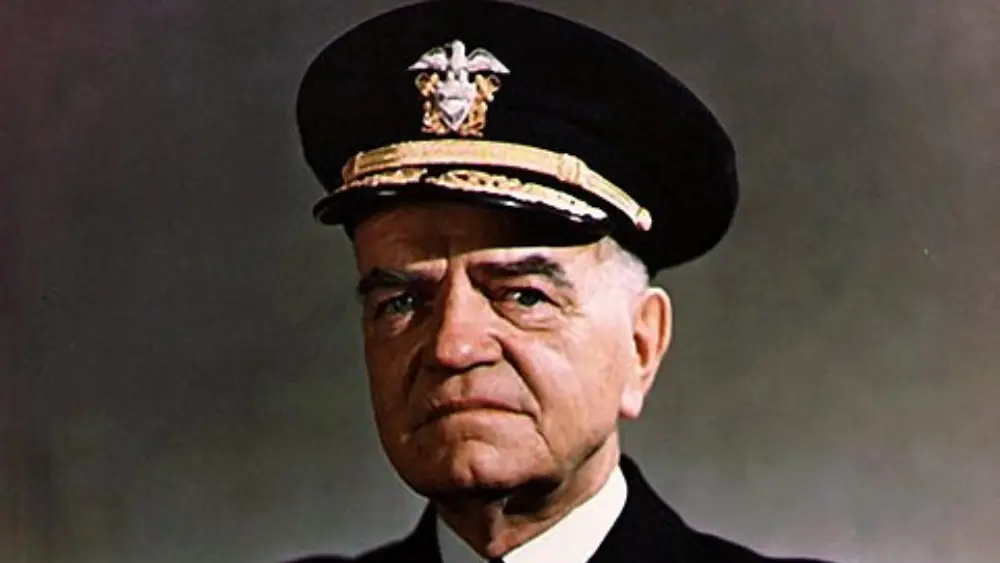William Frederick “Bull” Halsey Jr., a renowned U.S. Navy fleet admiral, made history as a pivotal WWII Pacific Theater commander. Born October 30, 1882, in Elizabeth, New Jersey, Halsey’s career peaked with his key role in the decisive Battle of Leyte Gulf.
Early Life and Naval Career
William Halsey’s early life was steeped in a profound fascination with the boundless expanse of the sea. From a young age, the allure of the ocean’s vastness and the sense of adventure it held captivated his imagination. This unwavering passion for maritime exploration and naval endeavors would shape the trajectory of his life in profound ways. His appointment to the U.S. Naval Academy marked the start of a remarkable naval career, a pivotal moment in his journey.
William Halsey’s lifelong dedication to the sea and the Naval Academy shaped his character and defined his legacy. His deep childhood connection to the maritime world guided his lifelong aspirations and ambitions as a constant compass. His passion instilled honor, duty, and service values, defining his successful naval career. Halsey’s journey, from the Naval Academy to WWII’s Pacific theater, showcased unwavering commitment to defending his nation and earning naval history acclaim.
William Halsey: World War II The Pacific Theater
During World War II, Halsey’s experience and leadership catapulted him to military recognition due to his exceptional qualities. His swift ascent through the ranks was a testament to his dedication and expertise. In the Pacific theater, Halsey’s brilliance left an enduring historical legacy, shining brightly in a tumultuous setting.
Leading in the Pacific, Halsey’s brilliance and resolve shaped the region’s wartime course, showcasing his strategic impact and unwavering determination. His unwavering spirit and leadership were key to the Allies’ eventual Pacific victory, making him a legendary figure at sea. Halsey’s valor and tenacity in World War II’s Pacific campaign cemented his revered status, synonymous with bravery amid adversity.
Command of the Third Fleet
In 1944, William Halsey’s stature in the Pacific Theater took a monumental leap as he assumed command of the Third Fleet. This pivotal appointment marked a defining moment in his career, one that would have far-reaching consequences. Halsey wasted no time in making his mark, and his leadership style quickly became emblematic of daring and audacity.
At the helm of the Third Fleet, Halsey’s aggressive and bold tactics defined his command approach. He was unafraid to take calculated risks and pursue audacious strategies, earning a reputation for his relentless pursuit of victory. Halsey’s fearless leadership shaped major Pacific battles, leaving an indelible mark on naval tactics and solidifying him as a determined Allied commander. Under his leadership, the Third Fleet thrived, and Halsey’s bold, innovative legacy echoed long after the war’s conclusion.
The Battle of Leyte Gulf
The 1944 Battle of Leyte Gulf is a pivotal event in naval history, occurring in the Pacific Ocean. This decisive confrontation marked a pivotal moment in the ongoing struggle between the U.S. Navy and the Imperial Japanese Navy during World War II. It went beyond tactics, symbolizing the intent to free the Philippines from Japanese occupation during the broader campaign.
As the battle raged on, the fate of nations hung in the balance. The outcome of the Battle of Leyte Gulf would have far-reaching consequences for the Pacific theater and beyond, ultimately playing a critical role in reshaping the course of history. This epic clash of naval powers showcased the valor, determination, and strategic acumen of commanders like William Halsey and etched their names into the annals of military legend as they worked tirelessly to secure victory and bring the Philippines one step closer to freedom.
“Bull” Halsey’s Role and Decision-Making
“Bull” Halsey’s pivotal role and decision-making during the Battle of Leyte Gulf in World War II showcased both his strategic brilliance and the potential pitfalls of his aggressive approach. Halsey’s decisions in this critical battle would reverberate throughout the conflict and beyond. His unwavering commitment to aggressive pursuit of the Japanese Northern Force, driven by a desire to achieve a decisive victory, had the unintended consequence of leaving the strategically vital San Bernardino Strait unguarded.
Halsey’s aggressive pursuit of the Japanese fleet, particularly the decoy carriers of the Northern Force, revealed his determination to secure a resounding victory for the Allied forces. This commitment to offensive action underscored his reputation as a bold and decisive leader. However, in his relentless pursuit, he failed to recognize the strategic importance of guarding the San Bernardino Strait, a vital passage that could have allowed the Japanese to launch a devastating counterattack. Halsey’s choice, while reflective of his aggressive nature, demonstrated the delicate balance between boldness and prudence in military decision-making. The Battle of Leyte Gulf serves as a stark reminder of the enduring impact that one leader’s choices can have on the course of history, as it altered the dynamics of the Pacific theater in World War II.
William Halsey: Taffy 3 and the Escort Carriers
William Halsey’s leadership was crucial in the Battle of Leyte Gulf, especially in defending Taffy 3 with escort carriers and destroyers. Taffy 3’s bravery against a superior Japanese force marked a defining moment in naval history. Halsey’s strategic decisions and the valor of the American sailors and airmen under his command during this engagement underscored the significance of the escort carriers in naval warfare and showcased the unwavering determination of the Allied forces in the face of overwhelming odds.
The Battle of Leyte Gulf and Taffy 3’s stand against the Japanese fleet became a symbol of resilience and resourcefulness. Halsey’s leadership, combined with the ingenuity of the escort carriers’ crews, ultimately thwarted the enemy’s intentions and prevented a potentially catastrophic outcome. This remarkable episode serves as a testament to the indomitable spirit of those who serve in the armed forces. Their ability to adapt and prevail in the most challenging circumstances.
Aftermath and Legacy
The Battle of Leyte Gulf was a costly but decisive turning point in World War II, with the U.S. victorious. At the heart of this achievement was the exemplary leadership of William “Bull” Halsey. His strategic skill and unwavering determination were pivotal in securing this triumph, highlighting leadership’s importance in wartime success.
The legacy of the Battle of Leyte Gulf extends beyond its immediate impact, influencing future naval tactics and strategies. Halsey’s bold leadership and the bravery of American sailors and airmen under him stand as a lasting testament to the U.S. Navy’s courage. This historic battle remains a poignant reminder of sacrifices in the Pacific theater, shaping enduring history.

William Halsey: Postwar Honors and Retirement
Following World War II, William Halsey’s remarkable contributions to the U.S. Navy earned him a multitude of accolades and honors, solidifying his legacy as a distinguished military leader. His strategic brilliance during pivotal battles, including the Battle of Leyte Gulf, garnered widespread recognition and admiration. In 1947, Halsey retired from the Navy after a decades-long career that profoundly shaped naval warfare.
Despite his retirement from active service, Halsey’s influence persisted in the postwar era. He remained prominent in the military, offering insights and expertise to evolving U.S. Navy strategies and doctrines. Halsey’s legacy, post-retirement, shaped naval operations and solidified his status as an American military history icon.





Admiral Halsey’s failure to leave Task Force 34 behind to guard the San Bernadino straits was a profound tactical error, and should have been the justification for an official reprimand from the chief of Naval Operations.